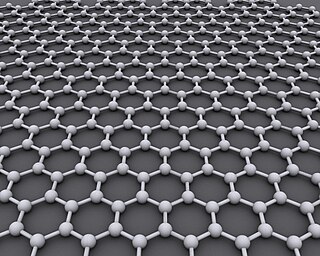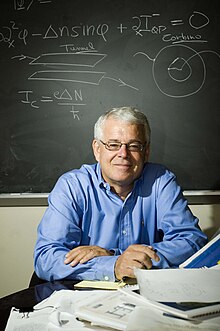
Superconductivity is a set of physical properties observed in certain materials where electrical resistance vanishes and magnetic fields are expelled from the material. Any material exhibiting these properties is a superconductor. Unlike an ordinary metallic conductor, whose resistance decreases gradually as its temperature is lowered, even down to near absolute zero, a superconductor has a characteristic critical temperature below which the resistance drops abruptly to zero. An electric current through a loop of superconducting wire can persist indefinitely with no power source.
Unconventional superconductors are materials that display superconductivity which does not conform to conventional BCS theory or its extensions.

Graphene is an allotrope of carbon consisting of a single layer of atoms arranged in a hexagonal lattice nanostructure. The name is derived from "graphite" and the suffix -ene, reflecting the fact that the graphite allotrope of carbon contains numerous double bonds.
A superlattice is a periodic structure of layers of two materials. Typically, the thickness of one layer is several nanometers. It can also refer to a lower-dimensional structure such as an array of quantum dots or quantum wells.

In condensed matter physics, Hofstadter's butterfly is a graph of the spectral properties of non-interacting two-dimensional electrons in a perpendicular magnetic field in a lattice. The fractal, self-similar nature of the spectrum was discovered in the 1976 Ph.D. work of Douglas Hofstadter and is one of the early examples of modern scientific data visualization. The name reflects the fact that, as Hofstadter wrote, "the large gaps [in the graph] form a very striking pattern somewhat resembling a butterfly."

Tungsten ditelluride (WTe2) is an inorganic semimetallic chemical compound. In October 2014, tungsten ditelluride was discovered to exhibit an extremely large magnetoresistance: 13 million percent resistance increase in a magnetic field of 60 tesla at 0.5 kelvin. The resistance is proportional to the square of the magnetic field and shows no saturation. This may be due to the material being the first example of a compensated semimetal, in which the number of mobile holes is the same as the number of electrons. Tungsten ditelluride has layered structure, similar to many other transition metal dichalcogenides, but its layers are so distorted that the honeycomb lattice many of them have in common is in WTe2 hard to recognize. The tungsten atoms instead form zigzag chains, which are thought to behave as one-dimensional conductors. Unlike electrons in other two-dimensional semiconductors, the electrons in WTe2 can easily move between the layers.

Proximity effect or Holm–Meissner effect is a term used in the field of superconductivity to describe phenomena that occur when a superconductor (S) is placed in contact with a "normal" (N) non-superconductor. Typically the critical temperature of the superconductor is suppressed and signs of weak superconductivity are observed in the normal material over mesoscopic distances. The proximity effect is known since the pioneering work by R. Holm and W. Meissner. They have observed zero resistance in SNS pressed contacts, in which two superconducting metals are separated by a thin film of a non-superconducting metal. The discovery of the supercurrent in SNS contacts is sometimes mistakenly attributed to Brian Josephson's 1962 work, yet the effect was known long before his publication and was understood as the proximity effect.
Pomeranchuk cooling is the phenomenon in which liquid helium-3 will cool if it is compressed isentropically when it is below 0.3 K. This occurs because helium-3 has the unusual property that its solid state can have a higher entropy than its liquid state. The effect was first observed by Yuri Anufriev in 1965. This can be used to construct a cryogenic cooler.
Bilayer graphene is a material consisting of two layers of graphene. One of the first reports of bilayer graphene was in the seminal 2004 Science paper by Geim and colleagues, in which they described devices "which contained just one, two, or three atomic layers"
Eva Yocheved Andrei is an American condensed matter physicist, a Distinguished Professor, and a Board of Governors Professor at Rutgers University. Her research focuses on emergent properties of matter arising from the collective behavior of many particles, especially low-dimensional phenomena under low temperatures and high magnetic fields.
A graphene morphology is any of the structures related to, and formed from, single sheets of graphene. 'Graphene' is typically used to refer to the crystalline monolayer of the naturally occurring material graphite. Due to quantum confinement of electrons within the material at these low dimensions, small differences in graphene morphology can greatly impact the physical and chemical properties of these materials. Commonly studied graphene morphologies include the monolayer sheets, bilayer sheets, graphene nanoribbons and other 3D structures formed from stacking of the monolayer sheets.

Twistronics is the study of how the angle between layers of two-dimensional materials can change their electrical properties. Materials such as bilayer graphene have been shown to have vastly different electronic behavior, ranging from non-conductive to superconductive, that depends sensitively on the angle between the layers. The term was first introduced by the research group of Efthimios Kaxiras at Harvard University in their theoretical treatment of graphene superlattices.
Pablo Jarillo-Herrero is a Spanish physicist and current Cecil and Ida Green Professor of Physics at Massachusetts Institute of Technology (MIT).
Sefaattin Tongay is an American-Jewish materials scientist and engineer internationally recognized for materials manufacturing of emergent semiconductors and quantum materials. He is the chair of Materials Science and Engineering at Arizona State University and serves as an associate editor at American Institute of Physics (AIP) Applied Physics Reviews and Nature 2D materials & applications by Nature.
Rafi Bistritzer is an Israeli physicist, and manager of an algorithms group at Applied Materials. He is the winner of the 2020 Wolf Prize in Physics, together with Pablo Jarillo-Herrero and Alan MacDonald, for “pioneering theoretical and experimental work on twisted bilayer graphene.”
The term heterostrain was proposed in 2018 in the context of materials science to simplify the designation of possible strain situations in van der Waals heterostructures where two two-dimensional materials are stacked on top of each other. These layers can experience the same deformation (homostrain) or different deformations (heterostrain). In addition to twist, heterostrain can have important consequences on the electronic and optical properties of the resulting structure. As such, the control of heterostrain is emerging as a sub-field of straintronics in which the properties of 2D materials are controlled by strain. Recent works have reported a deterministic control of heterostrain by sample processing or with the tip of an AFM of particular interest in twisted heterostructures. Heterostrain alone has also been identified as a parameter to tune the electronic properties of van der Waals structures as for example in twisted graphene layers with biaxial heterostrain.
A Josephson diode is an electronic device that superconducts electrical current in one direction and is resistive in the other direction. The device is a Josephson junction exhibiting a superconducting diode effect (SDE). It is an example of a quantum material Josephson junction (QMJJ), where the weak link in the junction is a quantum material. The Josephson diode effect can occur in superconducting devices where time reversal symmetry and inversion symmetry are broken.
Leslie Mareike Schoop is a German materials chemist who is an associate professor at Princeton University. Her research considers the realization of new materials for quantum technologies. She has identified several new topological materials, including the non-toxic, air-stable topological semi-metal ZrSiS.
Amalia Patanè is an Italian physicist who is Professor of Physics at the University of Nottingham and UK Director of the European Magnetic Field Laboratory.
Fractional Chern insulators (FCIs) are lattice generalizations of the fractional quantum Hall effect that have been studied theoretically since the early 2010's. They were first predicted to exist in topological flat bands carrying Chern numbers. They can appear in topologically non-trivial band structures even in the absence of the large magnetic fields needed for the fractional quantum Hall effect. They promise physical realizations at lower magnetic fields, higher temperatures, and with shorter characteristic length scales compared to their continuum counterparts. FCIs were initially studied by adding electron-electron interactions to a fractionally filled Chern insulator, in one-body models where the Chern band is quasi-flat, at zero magnetic field. The FCIs exhibit a fractional quantized Hall conductance.






